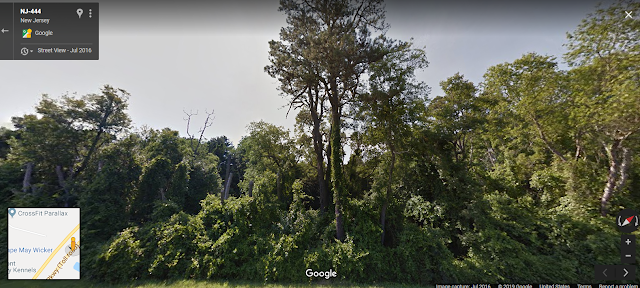Wikipedia defines kudzu (Pueraria montana var. lobata) thusly:
Kudzu is an invasive plant species in the United States. It has been spreading in the southern U.S. at the rate of 150,000 acres annually, "easily outpacing the use of herbicide spraying and mowing, as well increasing the costs of these controls by $6 million annually". This claim, however, was disputed in 2015 with the United States Forest Service estimating an increase of only 2,500 acres per year. Its introduction has produced devastating environmental consequences.
Kudzu grows a bit slower in the Northern Atlantic states because it goes dormant in winter here. Still, just 4 years ago, the Daily Record noted 'Kudzu ‘mile-a-minute’ vine spreads into Garden State' and pointed out it was here and that officials were denying it.
Anglers and hunters may find pockets of the kudzu, and my Weed Whacker worked overtime this summer to control a patch in Morristown, probably because of abundant rainfall. Unchecked, the vine climbs tree trunks.
Kudzu has been spreading across the U.S. at a rate as fast as 150,000 acres annually, because its individual vines can grow upward of a foot per day, giving it the “minute-a-mile” exaggeration.
New York Department Environmental Conservation last week declared Invasive Awareness Week and Region 3 officials and volunteers yesterday spent the morning pulling kudzu vines out in the Mianus River Gorge in Westchester.
If you Google “New Jersey kudzu,” officials say it’s a not a problem because the winters are too cold for kudzu. New York and other states know.
Of course that is bullshit. 2011: 'Vine That Ate the South' Discovered in West Cape May' and at the same time this pic from Princeton Nature Notes was published with the note, "This shot was taken last week at Princeton Battlefield, where the battle for Princeton's open space is currently being won by the kudzu of the north--porcelainberry. A vine native to northeast Asia, porcelainberry is related to grapes, and grows over ground, shrubs and trees like a grapevine on steriods."
Princeton is roughly 132 miles from Cape May.
Rutgers' New Jersey Agricultural Experiment Station, in an undated post, states, "Kudzu is a high climbing vine that is more of a problem in the deep south where it will overgrow trees in a short time. In our state the winters are too much for it and it is much slower growing. A survey by the NJ Dept. of Agriculture revealed 58 locations in the state. Only one of these (in Red Bank) was of a serious nature. It was introduced as a soil conservation aid and became too much at home."
Michael Young, writing for the NEW YORK-NEW JERSEY TRAIL CONFERENCE, points out:
Those of us in New York and New Jersey may have heard of the plant or seen it on travels as I did, but it comes as a surprise to most that we have kudzu in our area, too. Similar “solutions” brought it to the North: erosion control and the occasional ornamental planting. Until I joined the Trail Conference and the Lower Hudson PRISM last year, I was one of the people who believed kudzu was a Southern problem and our cold climate couldn’t support the vine. As it turns out, kudzu is perfectly content in our region, and with climate change occurring, will likely become more aggressive in the coming decades.
But there is hope! Under New York State Department of Environmental Conservation (DEC) NYCRR Part 575 Invasive Species Regulations, kudzu became a prohibited plant in New York State. This has made it illegal to knowingly sell, import, purchase, transport, introduce, or propagate kudzu. A couple years ago, the DEC began to actively manage known populations, and the Trail Conference assumed responsibility for the majority of the sites in the Lower Hudson Valley in 2018. There are around 40 populations being managed with the intention to completely remove it from the region. This is an organized effort of DEC crews, the Lower Hudson PRISM’s Invasive Strike Force, “friends of ” organizations, and private invasive management companies working toward a common goal of invasive plant management.
This past season, the Trail Conference’s Invasive Strike Force, with help from the folks at the NYS DEC, Naja Kraus, Andrew Moska-Lee, and Sylvia Albrecht, was able to continue management on 16 kudzu populations. We are seeing good progress. The monocultures of kudzu are being knocked back quickly, and subsequent crews are finding only individual plants mixed amongst other plants. Sites are beginning to have no kudzu plants present, showing that eradication from our region is a real possibility. This effort has been awesome, and with continued support and management, we really do have a chance to nip this one in the bud before climate change allows it to become established here.
How established is Kudzu in New Jersey? Drive the New Jersey Parkway from Cape May to Point Pleasant and then drive Route 195 to Princeton and guess what? The entire 150 mile drive shows off Kudzu route at the base of the highways, North and South / East and West, beginning to devour the trees - including the Pine Barrens. Here, via Google, is the Garden State Parkway in 2016, near 149 Landing Rd, Cape May Court House, NJ 08210:
That vine green/yellowish mass of leaves climbing up to devour that tree? Kudzu Root.
Please follow Bob's Blitz on Twitter for exclusive Blitz stories.
Tweet


